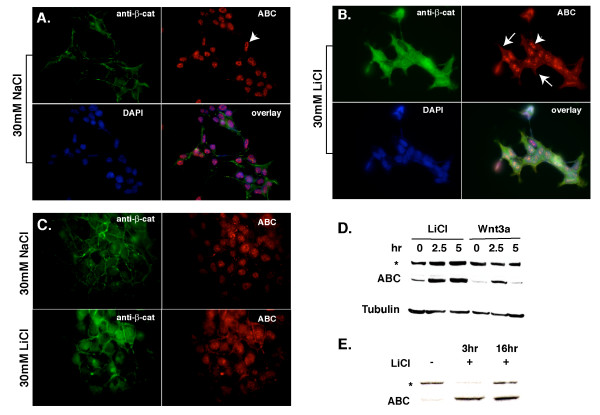Figure 1.
Subcellular localization of signaling and total forms of β-catenin in HEK 293T cells. A-C: HEK 293T cells were treated with 30 mM NaCl (control, A) or 30 mM LiCl (B) for 16 hours to induce the post-transcriptional accumulation of cytosolic/nuclear β-catenin. Cells were co-immunostained using a polyclonal antibody raised against the consensus GSK3 phosphorylation sites of human β-catenin (#06-734; Millipore), and a monoclonal antibody that recognizes ABC (8E7, Millipore). DAPI was used to stain cell nuclei. A. NaCl (control)-treated cells display a small amount of junctional and cytoplasmic β-catenin (green), while ABC (red) is found exclusively in the nuclear compartment. B. In the presence of Wnt signaling, cells show increased expression and colocalization of total-β-catenin and ABC in the cytoplasm and nucleus. Note that the punctate, nuclear ABC staining remains largely unchanged after LiCl induction (arrowheads). Rather, a diffuse cyto/nucleoplasmic ABC staining pattern is most evident (arrows in B). No staining is observed with goat-anti-rabbit IgG (GAR) and goat anti-mouse IgG (GAM) secondary antibodies alone (not shown). Exposure times for anti-β-catenin (green) and ABC (red) images are 1215 and 1632 milliseconds, respectively. C. Same experiment as A&B except exposure times were matched for the two β-catenin antibodies (1000 ms). D&E. Immunoblot analysis of HEK cells treated with LiCl or recombinant mouse Wnt3a protein (R&D Systems #1324-WN/CF). Note that 8E7 detects ABC as well as a non-specific band at ~160 kDa (*).

